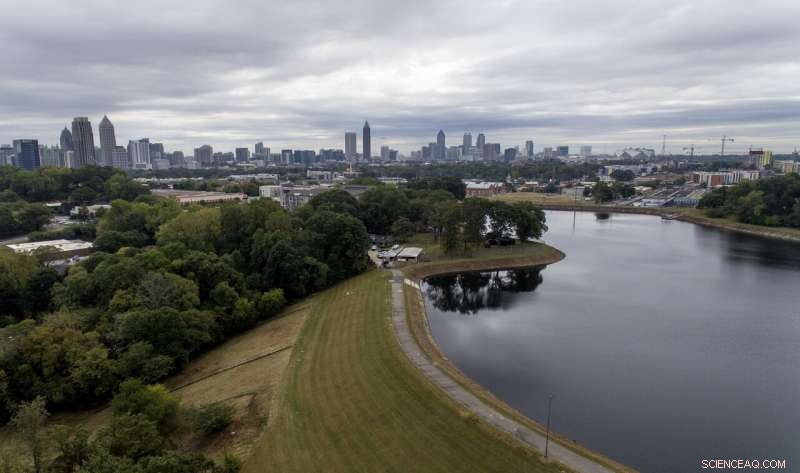
Serbatoio n. 1, una fornitura d'acqua da 180 milioni di galloni che è stata fuori servizio per gran parte degli ultimi decenni, si trova sullo sfondo dello skyline della città, 15 ottobre 2019, ad Atlanta. La città ha effettuato le riparazioni e l'ha rimessa in funzione nel 2017, solo per spegnerlo di nuovo dopo che sono state notate perdite d'acqua vicino alle aziende situate sotto la diga. Se la diga dovesse fallire catastroficamente, l'acqua potrebbe inondare più di 1, 000 case unifamiliari, decine di imprese, una ferrovia e una parte dell'Interstate 75, secondo un piano di emergenza. (Foto AP/David Goldman)
In una fredda mattina dello scorso marzo, Kenny Angel ha bussato freneticamente alla sua porta. Due lavoratori di una società di servizi pubblici nel nord del Nebraska erano arrivati con un duro avvertimento:esci da casa tua.
Poco più di un quarto di miglio a monte, il 92enne Spencer Dam si sforzava di contenere il gonfiore, fiume Niobrara coperto di ghiaccio dopo una neve e un temporale insolitamente intensi. Gli operai avevano provato, senza riuscirci, a forzare l'apertura dei cancelli di scarico in legno ghiacciato della diga. Così, temendo il peggio, sono fuggiti nel loro camion, fermandosi per avvertire Angel prima di partire senza di lui.
Minuti più tardi, la diga è crollata, scatenando un'ondata d'acqua che trasporta pezzi di ghiaccio grandi come automobili. La casa di Angel è stata spazzata via; il suo corpo non è mai stato ritrovato.
"Aveva un preavviso di circa 5 minuti, senza preavviso il giorno prima, "Scott Angelo, uno dei fratelli di Kenny, disse.
Gli ispettori statali avevano dato alla diga un rating "equo" meno di un anno prima. Fino a quando non ha fallito, sembrava poco diverso da migliaia di altri negli Stati Uniti, e questo potrebbe far presagire un problema.
Un'indagine di oltre due anni dell'Associated Press ha trovato decine di dighe a livello nazionale in condizioni ancora peggiori, e in luoghi ugualmente pericolosi. Incombono sulle case, imprese, autostrade o intere comunità che potrebbero affrontare inondazioni pericolose per la vita se le dighe non resistono.
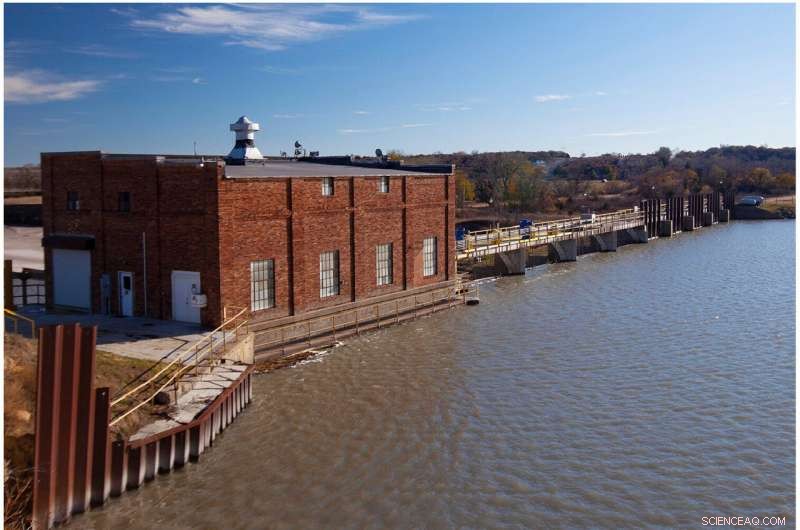
Questa combinazione di foto fornite dal Dipartimento delle risorse naturali del Nebraska, mostra la diga di Spencer vicino a Spencer, Neb., nel novembre 2013, superiore, quando tratteneva l'acqua sul fiume Niobrara e di nuovo nel marzo 2019, dopo che la diga è fallita durante un'alluvione. Gli ispettori statali avevano dato alla diga un rating "equo" meno di un anno prima. Fino a quando non ha fallito, sembrava poco diverso da migliaia di altri negli Stati Uniti, e questo potrebbe far presagire un problema. (Dipartimento delle risorse naturali del Nebraska tramite AP)
Una revisione dei dati federali e dei rapporti ottenuti in base alle leggi statali sui registri aperti ha identificato 1, 688 dighe ad alto rischio classificate in condizioni scadenti o insoddisfacenti a partire dall'anno scorso in 44 stati e Porto Rico. Il numero effettivo è quasi certamente più alto:alcuni stati hanno rifiutato di fornire valutazioni delle condizioni per le loro dighe, rivendicare esenzioni alle richieste di pubblici registri. Altri semplicemente non hanno valutato tutte le loro dighe a causa della mancanza di fondi, personale o l'autorità per farlo.
I decessi per guasti alle dighe sono diminuiti da quando una serie di crolli catastrofici negli anni '70 ha spinto i governi federale e statale a intensificare i loro sforzi per la sicurezza. Eppure circa 1, 000 dighe sono fallite negli ultimi quattro decenni, uccidendo 34 persone, secondo il National Performance of Dams Program della Stanford University.
Costruito per il controllo delle inondazioni, irrigazione, fornitura d'acqua, energia idroelettrica, ricreazione o stoccaggio di rifiuti industriali, le dighe della nazione hanno in media più di mezzo secolo. Alcuni non sono più adeguati per gestire le intense precipitazioni e le inondazioni di un clima che cambia. Eppure si fa affidamento su di loro per proteggere sempre più persone man mano che sorgono insediamenti abitativi nelle vicinanze.
"Ci sono migliaia di persone in questo Paese che vivono a valle di dighe che probabilmente sono considerate carenti visti gli attuali standard di sicurezza, " ha detto Mark Ogden, un ex funzionario per la sicurezza della diga dell'Ohio che ora è uno specialista tecnico con l'Association of State Dam Safety Officials.
L'associazione stima che servirebbero più di 70 miliardi di dollari per riparare e modernizzare gli oltre 90 della nazione, 000 dighe. Ma a differenza di molte altre infrastrutture, la maggior parte delle dighe statunitensi sono di proprietà privata. Ciò rende difficile per i regolatori richiedere miglioramenti agli operatori che non sono in grado o non sono disposti a pagare i costi elevati.
"La maggior parte delle persone non ha idea delle vulnerabilità quando vivono a valle di queste dighe private, " ha detto Craig Fugate, un ex amministratore presso l'Agenzia federale per la gestione delle emergenze. "Quando falliscono, non falliscono con l'avvertimento. semplicemente falliscono, e all'improvviso puoi trovarti in una situazione in cui hai un muro di acqua e detriti che corrono verso casa tua in pochissimo tempo, se del caso, per uscire."
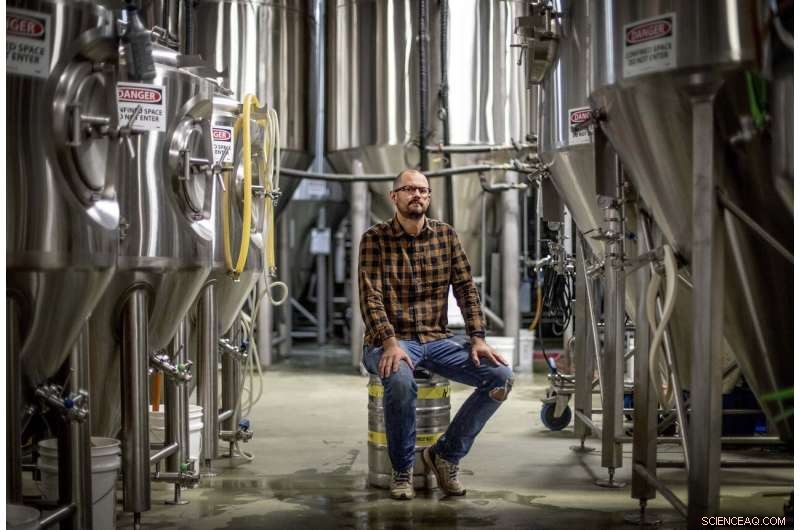
Joel Iverson, direttore operativo di Monday Night Brewing, è fotografato nel birrificio che si trova accanto al serbatoio n. 1, una fornitura d'acqua da 180 milioni di galloni che è stata fuori servizio per gran parte degli ultimi decenni, 15 ottobre 2019, ad Atlanta. Iverson aveva già notato che l'acqua sgorgava dalla collina della diga vicino al birrificio da lui co-fondato. "Se quello va, ci laverà via e un sacco di birra, " ha detto Iverson. (AP Photo/David Goldman)
___
Non è chiaro se Angelo, un veterano della guerra del Vietnam di 71 anni, ha rifiutato di fuggire o semplicemente ha esaurito il tempo dopo che i lavoratori del Nebraska Public Power District lo hanno avvertito che l'acqua stava traboccando la diga vicino a Spencer, una città di meno di 500 abitanti.
Un avvocato per la moglie di Angel, che non era a casa quando la diga si è rotta, ha intentato una causa da $ 5 milioni per negligenza. Afferma che l'azienda elettrica non è riuscita a mantenere correttamente la diga, formare i propri dipendenti o informare gli Angeli di condizioni pericolose.
Anche se la casa degli angeli era esattamente sul suo cammino, la diga è stata valutata come un pericolo "significativo" piuttosto che "alto", il che significa che non era richiesto dalla legge del Nebraska per avere un piano d'azione di emergenza formale. Circa il 20% delle dighe ad alto rischio regolamentate dallo stato a livello nazionale mancano ancora di piani di emergenza, secondo il Corpo degli Ingegneri dell'Esercito degli Stati Uniti, che mantiene l'inventario nazionale delle dighe.
Al momento dell'ultima ispezione nell'aprile 2018 , La valutazione "equa" di Spencer Dam è stata accompagnata da un'annotazione inquietante:"Esistono carenze che potrebbero portare al cedimento della diga durante rari, eventi di tempesta estrema."
Tim Gokie, capo ingegnere del programma di sicurezza della diga del Nebraska, ha affermato che l'avvertimento era dovuto a infiltrazioni d'acqua passate che l'azienda elettrica ha affrontato installando un sistema di drenaggio. In definitiva, Gokie ha detto, l'innalzamento del fiume Niobrara ha semplicemente travolto la diga di cemento e terra, costruito nel 1927 per generare energia idroelettrica, non per il controllo delle inondazioni.
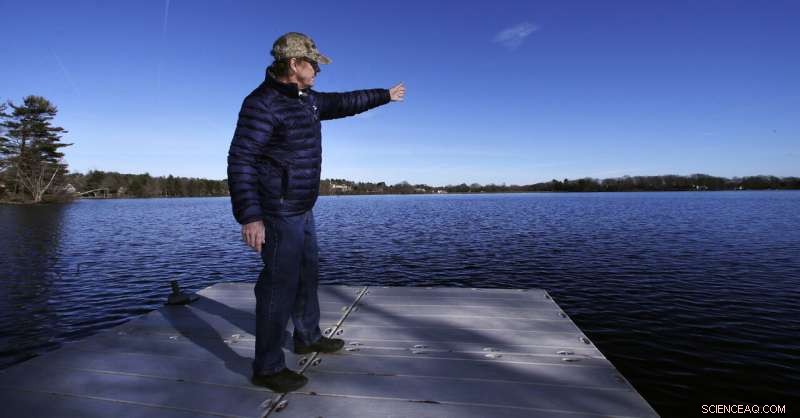
In questo 27 dicembre, 2018, foto, Murray Beach, un banchiere d'investimenti che vive sulla riva del Willett Pond, indica lo sfioratore del lago, che si trova al confine tra Norwood e Walpole, Mass. Lo sfioratore della diga Willett Pond, che ha 107 anni, è in grado di gestire solo il 13% del flusso d'acqua di una grave alluvione prima che la diga venga superata, secondo un recente rapporto di ispezione statale. "Non stiamo parlando solo di allagare la casa di qualcuno. Stiamo parlando di coprire la loro casa, " disse Spiaggia, che fa parte di un gruppo di cittadini che da anni fa pressioni per la riparazione dello sfioratore. (Foto AP/Charles Krupa)
"Il fatto era che era solo una situazione senza precedenti, Il portavoce del Nebraska Public Power District Mark Becker ha detto. "Era oltre quello che tutti si aspettavano".
Il Nebraska è stato tra gli stati più colpiti quest'anno da tempeste e inondazioni che hanno causato danni alle strade per circa 1,5 miliardi di dollari. dighe, servizi pubblici e altre infrastrutture in 28 stati, secondo un'analisi AP.
Una valutazione nazionale del clima pubblicata dalla Casa Bianca lo scorso anno ha rilevato una frequenza e un'intensità crescenti delle tempeste mentre il clima cambia. Ciò può spingere alcune dighe oltre ciò per cui sono state progettate.
Anche se tenuto in buone condizioni, thousands of dams could be at risk because of extreme rainstorms, said Fugate, the former FEMA official.
"These are like ticking bombs just sitting there, waiting for the wrong conditions to occur to cause catastrophic failure, " Egli ha detto.
___
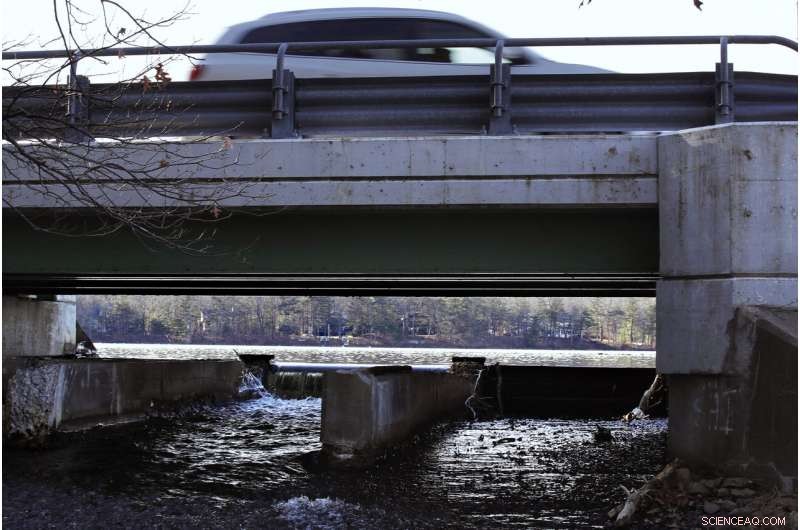
A vehicle passes over the spillway at Willett Pond on the border of Norwood and Walpole, Mass., Dec. 27, 2018. If the dam were to give way, it could send hundreds of millions of gallons of water into the heart of the Norwood, a Boston suburb of nearly 30, 000 persone. (AP Photo/Charles Krupa)
The nation's dams are categorized as high, significant or low hazard in the National Inventory of Dams database. High hazard means loss of human life is likely if a dam were to fail. A significant rating means no deaths are likely, although economic and environmental damage are possible.
There is no national standard for inspecting dams, leading to a patchwork of state regulations. Some states inspect high-hazard dams every year while others wait up to five years. Some states never inspect low-hazard dams—though even farm ponds can eventually pose a high hazard as housing developments encroach.
Dam conditions are supposed to be rated as unsatisfactory, poor, fair or satisfactory. But the ratings are subjective—varying by state and the interpretations of individual inspectors—and are not always publicly disclosed.
Since the Sept. 11, 2001, terror attacks, the U.S. government has cited national security grounds in refusing to include dams' conditions in its inventory, which was updated most recently in 2018. But the AP was able to determine both condition and hazard ratings for more than 25, 000 dams across the country through public records requests.
The tally includes some of the nation's most well-known dams, such as Hoover Dam along the Colorado River, but mostly involves privately owned dams. Many are used for recreation.
The AP then examined inspection reports for hundreds of high-hazard dams in poor or unsatisfactory condition. Those reports cited a variety of problems:leaks that can indicate a dam is failing internally; unrepaired erosion from past instances of overtopping; holes from burrowing animals; tree growth that can destabilize earthen dams; and spillways too small to handle a large flood. Some dams were so overgrown with vegetation that they couldn't be fully inspected.
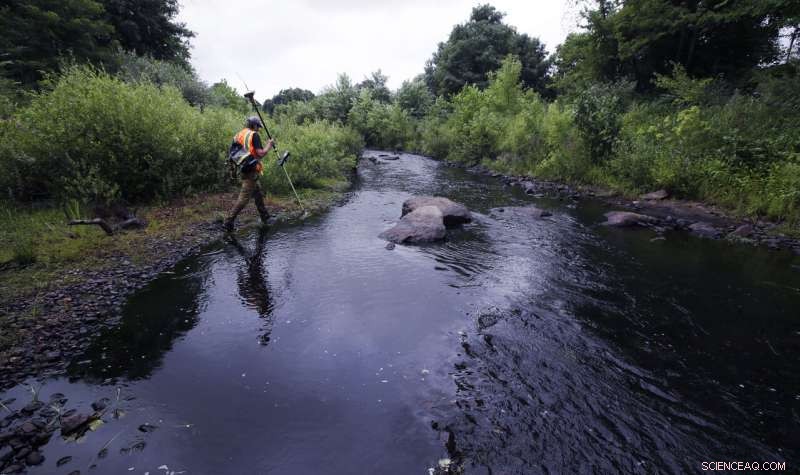
A surveyor walks the banks of the Mill River, at the site of the former Whittenton Pond Dam, just upstream from downtown Taunton, Mass., July 25, 2018. The dam was removed following concerns that the 170-year-old plus structure could fail, after it buckled and nearly failed in 2005. (AP Photo/Charles Krupa)
Georgia led the nation with nearly 200 high-hazard dams in unsatisfactory or poor condition, according to the AP's analysis.
Among them is Reservoir No. 1 in Atlanta, a 180 million-gallon water supply dating to the late 1800s that has been out of service much of the past few decades. The city made repairs and brought it back online in 2017, only to shut it down again after leaks were noticed.
If the dam were to catastrophically fail, the water could inundate more than 1, 000 case, dozens of businesses, a railroad and a portion of Interstate 75, according to an emergency action plan .
Joel Iverson has previously noticed water trickling out of the dam near the brewery he co-founded, Monday Night Brewing.
"If that one goes, it's going to wash away us and a lot of beer, " Iverson said.
The Atlanta Watershed Management Department declined the AP's request for an interview about the reservoir and instead asked for questions in writing. When those were submitted, it declined to answer them.
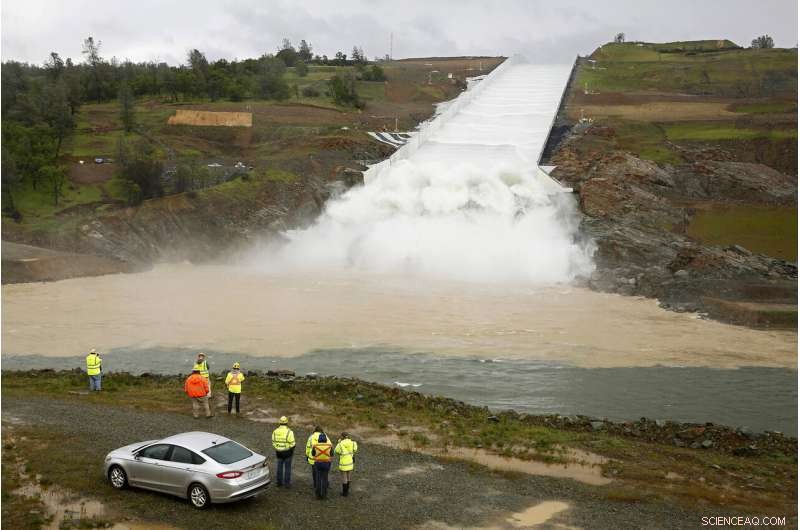
In this April 2, 2019, foto d'archivio, water flows down the Oroville Dam spillway in Oroville, Calif. The state spent $1.1 billion repairing the Lake Oroville spillway, enacted new emergency plan requirements and launched a review of 93 other dams with similar spillways. (AP Photo/Rich Pedroncelli, File)
___
One of the most common problems for aging dams are spillways incapable of handling an extreme rainfall event.
If water can't escape quickly enough through spillways, it could flow over the top of a dam, which increases the probability of rapid erosion that can cause it to collapse.
The spillway at the 107-year-old Willett Pond Dam near the Boston suburb of Norwood is capable of handling just 13% of the water flow from a serious flood before the dam is overtopped, according to a recent state inspection report. If the dam were to give way, it could send hundreds of millions of gallons of water into the heart of the city of nearly 30, 000 persone.
"We are not talking of just flooding someone's house. We are talking about covering their house, " said Murray Beach, who lives on the shore of the 220-acre privately owned lake and belongs to a citizens group that has lobbied for years for the spillway to be repaired.
A 2017 inspection report said improvements to the spillway could cost between $1 million and $5 million. A nonprofit that owns the lake received a $215, 000 state grant last year to design spillway improvements. But there is no timeline to fix it.
In this Nov. 30, 2017, foto d'archivio, work continues on the Oroville Dam spillway in Oroville, Calif. The scare at Oroville, the nation's tallest dam, led to evacuation orders for nearly 200, 000 persone, although no one was injured and the dam ultimately held. (AP Photo/Rich Pedroncelli, File) 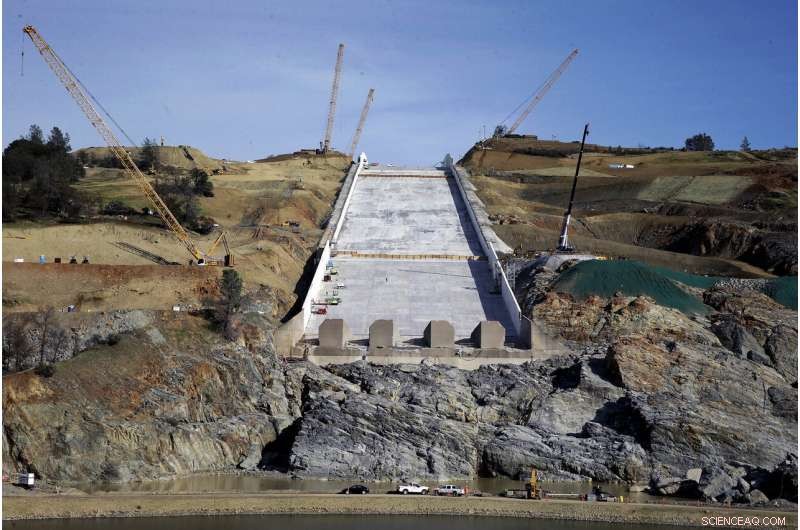
Tamiko Porter, who operates a Montessori school serving some 75 students, said she was surprised to learn there was a dam upstream that could flood her school if it failed.
"Oh God, please let it happen when my kids aren't here, " Porter said.
Norwood emergency management director Bernard Cooper said there is no imminent risk of dam failure.
"Sì, it needs work. The spillway should be rebuilt. Absolutely, no question, " Cooper acknowledged. But "there is no money in the system for that."
Concerns about inadequate dam spillways date back decades to when the Corps of Engineers undertook its first nationwide assessment of dams posing a high risk to life and property. From 1978 to 1981, the Corps inspected 8, 818 dams. About one-third were deemed unsafe due to deficiencies, and about 80% of those cited inadequate spillway capacities.
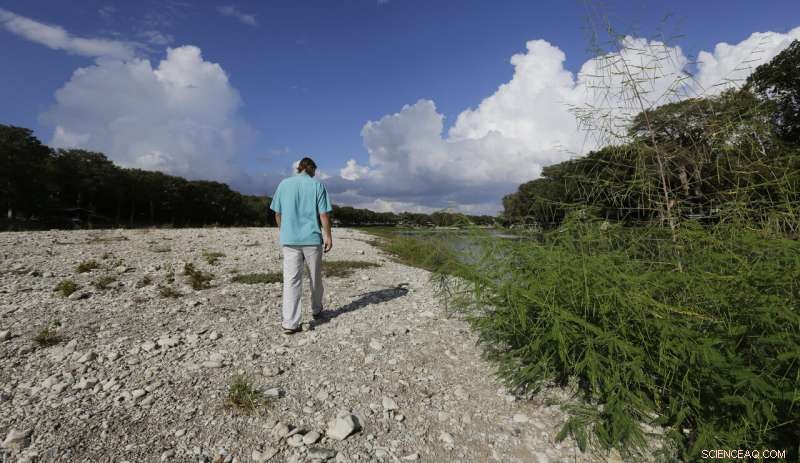
Hunter Croan walks along a dried-up section of Lake Dunlap, 30 settembre 2019, in Lake Dunlap, Texas. Croan is one of many homeowners who were left high and dry, their lakeside docks now dry as the Guadalupe River retreated to its natural bed after the the center spill gate of the lake's 91-year-old dam failed. (AP Photo/Eric Gay)
One of the dams cited for a "seriously inadequate" spillway in 1978 was Lake Sebago, located in a New York state park near the village of Sloatsburg. Forty years later, nothing has changed.
A 2018 state inspection letter warned of "inadequate spillway capacity and dam stability" and asked for an improvement plan within 30 days. None was provided.
The state dam safety office has no authority to force the state parks department to make repairs.
To modify the Lake Sebago spillway, workers would have to rebuild a road and bridge that pass over the dam. The project could cost over $15 million, said Jim Hall, the recently retired executive director of the Palisades Interstate Park Commission, which manages multiple dams.
"That structure has been in place with the same spillway capacity for over probably 60 to 70 years and it hasn't been overtopped, " Hall said. "Should it be improved to meet all codes? Yeah, that would be nice. Does it make it the highest priority for us to do in relation to other dam structures we have? Probably not."
___
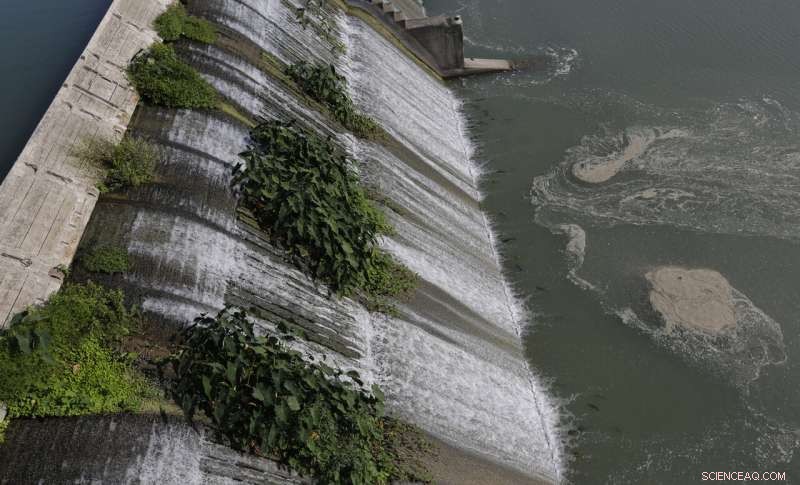
Water flows over a spill gate on Lake McQueeney, 2 ottobre 2019, Lake McQueeney, Texas. A judge has issued a 12-month temporary injunction preventing the draining of McQueeney and five other lakes along the Guadalupe River after property owners sued. (AP Photo/Eric Gay)
In a 1982 report summarizing its nationwide dam assessment, the Corps of Engineers said most dam owners were unwilling to modify, repair or maintain the structures, and most states were unwilling to spend enough money for an effective dam safety program.
Da allora, every state but Alabama has created a dam safety program.
But the Great Recession a decade ago forced many states to make widespread budget and personnel cuts. Since a low point in 2011, states' total spending on dam safety has grown by about one-third to nearly $59 million in the 2019 fiscal year while staffing levels have risen by about one-fifth, according to data collected by the Corps of Engineers.
California, which runs the nation's largest dam safety program, accounts for much of that gain. It boosted its budget from $13 million to $20 million and the number of full-time staff from 63 to 77 following the failure of the Oroville dam spillway in 2017.
The scare at Oroville, the nation's tallest dam, led to evacuation orders for nearly 200, 000 persone, although no one was injured and the dam ultimately held. An independent investigation cited "a long-term systemic failure " by regulators and the dam industry to recognize and address warning signs.
California spent $1.1 billion repairing the Lake Oroville spillway, enacted new emergency plan requirements and launched a review of 93 other dams with similar spillways.
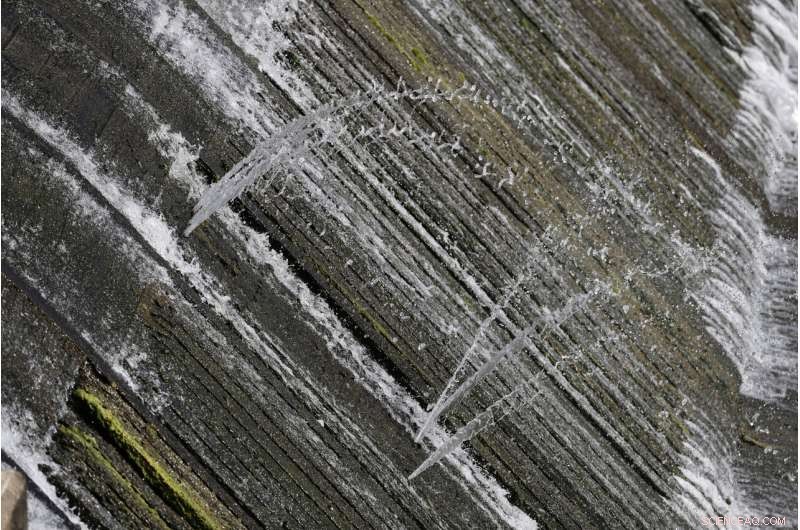
Water spurts through a wood section of a spill gate on Lake McQueeney, 2 ottobre 2019, Lake McQueeney, Texas. A judge has issued a temporary injunction preventing the draining of the lakes along the Guadalupe River as a result of an agreement between suing property owners and the Guadalupe-Blanco River Authority. (AP Photo/Eric Gay)
In South Carolina, after more than 70 dams failed following heavy rains in 2015 and 2016, the state tripled the personnel in its dam safety program and ratcheted up spending from about $260, 000 annually to more than $1 million.
But some states have continued to pare back their dam safety programs. Thirteen states and Puerto Rico were spending less in 2019 than they did in 2011, and 11 states had fewer full-time positions in their programs.
The Association of State Dam Safety Officials says almost every state faces a serious need to pump additional money and manpower into dam safety programs.
"If you don't have the staff to inspect a dam, or don't have the authority to do that, you don't know what the problems are, " said the association's Ogden.
"If you are able to do the inspection but you can't follow up, and you have dam owners who don't have the resources to fix their dam, then ultimately you know what the problem is but you can't get it addressed, " Ha aggiunto.
Many states face a quandary when it comes to problematic private dams when they can't identify the owners. Rhode Island's two-person dam safety office last year listed 32 high- or significant-hazard dams with safety concerns whose owners were unknown.
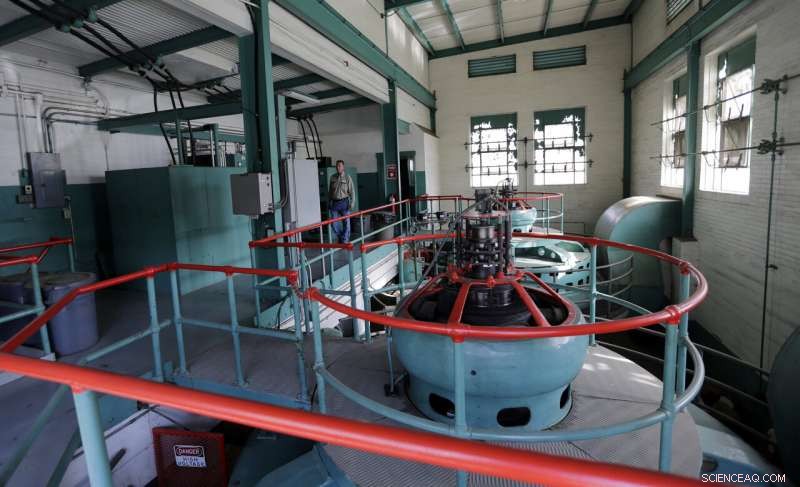
Guadalupe-Blanco River Authority's John Moryl walks through the hydroelectric plant at the spill gates on Lake McQueeney, 2 ottobre 2019, in Lake McQueeney, Texas. The Guadalupe-Blanco River Authority announced plans to drain a chain of six lakes, including Lake McQueeney. (AP Photo/Eric Gay)
"If we don't know the owner, then we can't take any action to order anybody to fix it, " said David Chopy, chief of compliance and inspection for the Rhode Island Department of Environmental Management.
In some states, dams go uninspected because of exemptions in state law.
A 2013 Texas law exempts all dams on private property with a capacity of less than 163 million gallons that are rated significant or low hazard and are located outside of city limits in any county with fewer than 350, 000 persone. Di conseguenza, about 45% of its roughly 7, 200 dams are exempt from regulation.
Missouri performs safety inspections on only about 650 of its more than 5, 000 dams. That's because state law exempts all dams that are under 35 feet, used for agricultural purposes or subject to federal regulation.
Former Missouri Gov. Matt Blunt attempted to significantly expand the number of dams under state supervision after the mountaintop Taum Sauk Reservoir collapsed in December 2005, injuring a state park superintendent's family. But the legislation failed after some rural landowners expressed concerns. Then the proposal quietly faded away as new officials took over.
"Maybe it's time to take a look at that again and make sure that our dams are safe, " said Missouri state Rep. Tim Remole, who now leads the House committee overseeing dam safety.
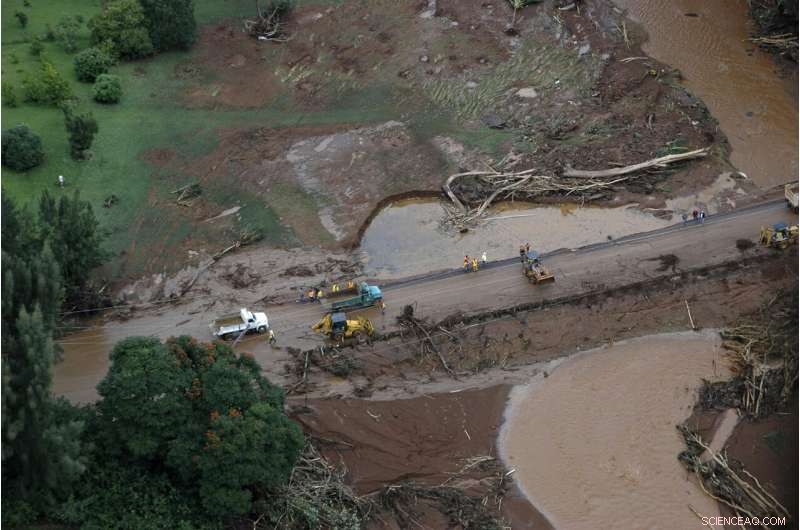
This March 14, 2006, foto d'archivio, shows damage after a dam burst near Kilauea, on the Hawaiian island of Kauai. An earthen wall of the Kaloko Reservoir collapsed during heavy rains and sent a wave of water and mud rushing down a hillside. Seven people were killed on Bruce Fehring's property, including his daughter, son-in-law and grandson. (AP Photo/Casey Riemer, File)
___
Until Angel's death in Nebraska this year, the last fatal dam failure in the U.S. occurred on the Hawaiian island of Kauai in 2006.
An earthen wall of the Kaloko Reservoir collapsed during heavy rains and sent a wave of water rushing down a hillside. Seven people—including a pregnant woman—were killed on Bruce Fehring's property, including his daughter, son-in-law and grandson.
Fehring, who wasn't there at the time, got a phone call from a neighbor saying something terrible had happened. He was shocked by the scene.
"It took a while to register, and I went, 'Oh my God, everything's been washed away, '" Fehring recalled. "I mean, you have no idea the power of water (until) you see what it can do in a very short amount of time."
Dam owner James Pflueger pleaded no contest to felony reckless endangerment and was sentenced to seven months of confinement and five years of probation. His property company pleaded no contest to seven counts of manslaughter. Prosecutors said Pflueger had filled in the dam's spillway while attempting to make space for a waterfront development.
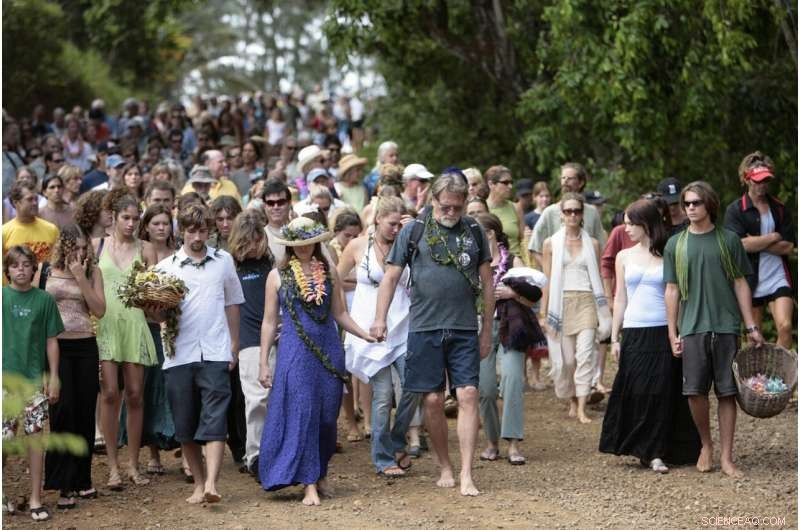
In this May 21, 2006, foto d'archivio, Bruce Fehring and his wife Cyndee, centro, lead a procession toward Kahili Quarry Beach during a memorial service to honor those killed when the Kaloko Dam failed in Kilauea, on the Hawaiian island of Kauai. An earthen wall of the Kaloko Reservoir collapsed during heavy rains and sent a wave of water and mud rushing down a hillside. Seven people were killed on Fehring's property, including his daughter, son-in-law and grandson. (Jamm Aquino/Honolulu Star-Bulletin via AP, File)
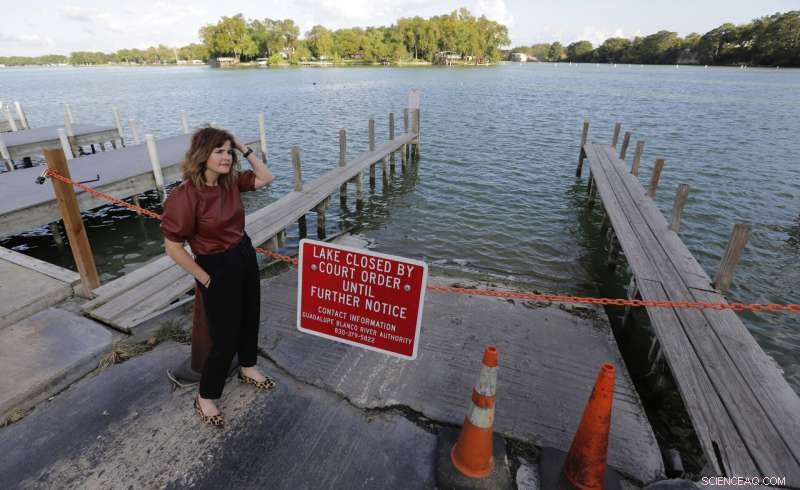
Tess Coody-Anders, a university executive and homeowner near Lake McQueeney, one of the dams slated to be drained, stands near a sign showing the lake is closed, 30 settembre 2019, in Lake McQueeney, Texas. "This is something that communities and states all across the country are grappling with as we are reckoning with our aging infrastructure, " said Coody-Anders. (AP Photo/Eric Gay)
The victims' families and those whose property was damaged, including actress Bette Midler, agreed to a $25 million civil settlement. Though categorized by the state as low hazard at the time it failed, Kaloko Reservoir is now listed as a high-hazard facility in poor condition . It remains largely unrepaired.
That's also the case with Lake Dunlap Dam, northeast of San Antonio. On a sunny morning in May, one of the 91-year-old dam's corroded spillway gates suddenly gave way. No one was hurt in the rush of water, but scores of homeowners' lakeside docks were left high and dry, facing barren swaths of dried lakebed after the river retreated, leaving boats stranded.
The dam was the second hydroelectric facility along the river to fail within the past three years. The Guadalupe-Blanco River Authority responded with plans to drain a chain of four lakes because of concerns their similarly designed spillway gates also could fail.
But after property owners sued, the river authority agreed in September to a temporary injunction delaying the plan for a year. That could allow time to find funding for the estimated $90 million to $210 million to repair the dams.
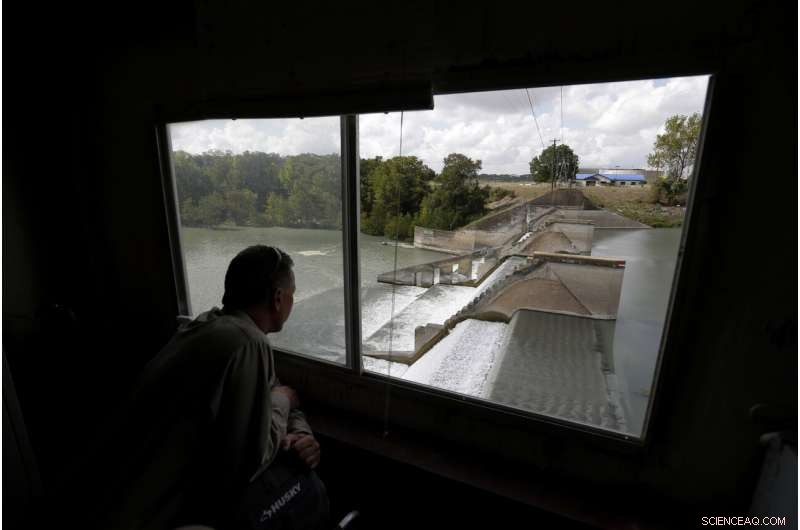
Guadalupe-Blanco River Authority's John Moryl looks over the spill gates at Lake Dunlap, 2 ottobre 2019, in Lake Dunlap, Texas. One of the spill gates at the dam failed in May and the lake drained down to the original channel of the Guadalupe River. (AP Photo/Eric Gay)
"This is something that communities and states all across the country are grappling with as we are reckoning with our aging infrastructure, " said Tess Coody-Anders, a homeowner near Lake McQueeney, one of the dams slated to be drained.
"I hope that everyone will recognize that, like in our community, entire economies and ways of life have developed around what started out as a civil engineering project, " she added. "And you can't take that away."
© 2019 The Associated Press. Tutti i diritti riservati.